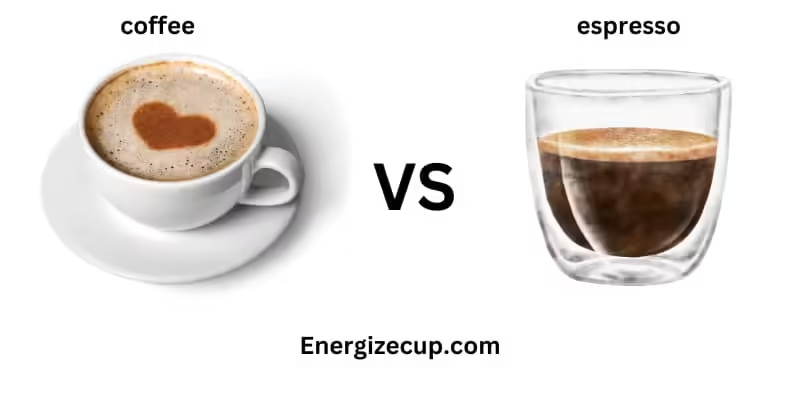Espresso is generally regarded as having a higher concentration of caffeine, containing approximately 63 mg per ounce, based on data from the Department of Agriculture.
In comparison, regular coffee contains between 12 and 16 mg of caffeine per ounce. This indicates that, ounce for ounce, espresso contains a significantly higher amount of caffeine. Espresso vs. Coffee Caffeine? Exploring the Differences: Espresso vs. Coffee
Visiting a coffee shop introduces you to a variety of drink options, including espresso and coffee. Each has its unique preparation and flavor, but what exactly sets them apart?
Espresso can be made from the same beans used for regular coffee, though some brands offer beans specifically roasted for espresso. These beans are typically less oily compared to those used for drip coffee.

The primary distinction between espresso and coffee lies in their brewing methods. Espresso is crafted using a machine that pushes hot water through finely ground, tightly packed coffee at high pressure.
This process yields a beverage with a robust flavor and creamy consistency, contrasting with drip coffee, which involves hot water filtering through coarser grounds.
Moreover, espresso often has a higher caffeine concentration per serving due to its dense composition. Although the beans may contain similar caffeine levels, the condensed nature of espresso means you consume more caffeine in a smaller volume.
When you next visit a café, keep in mind that while both espresso and coffee provide enjoyable flavors and a caffeine boost, they differ significantly in taste and are not interchangeable in recipes.
Enjoying both beverages allows you to appreciate their distinct qualities and decide which best suits your taste and caffeine preferences.
Also read: how much coffeine in latte dunkin?Caffeine Comparison: Espresso vs. Coffee
A significant number of Americans, nearly 87%, enjoy drinking coffee, with 32% of these individuals preferring espresso. Many enjoy coffee not only for its taste and aroma but also for the energizing effect it provides.
The debate between the caffeine content in espresso and regular coffee is a common one. Although espresso is often perceived as having more caffeine due to its stronger flavor, this isn’t entirely accurate.
To understand the true difference in caffeine levels between these two popular beverages, let’s examine the specific caffeine content in each. This will clarify whether espresso or coffee offers more of a caffeine boost per ounce.
Understanding Espresso and Americano: What’s the Difference?
When comparing different coffee drinks, a common question arises: what’s the difference between espresso and Americano?
Espresso is both a type of coffee and a brewing method. It involves using finely ground coffee beans to produce a concentrated shot of coffee through a high-pressure brewing process.
An Americano, while incorporating espresso, is a distinct drink. It is created by diluting a shot (or double shot) of espresso with hot water.

This process results in a beverage that has a milder flavor than pure espresso but retains the same caffeine content. The addition of water gives the Americano a similar strength and body to regular drip coffee but with a less intense taste compared to a straight shot of espresso.
In essence, while both drinks are based on espresso, an Americano offers a lighter, more watered-down experience, making it distinct from the bold, undiluted taste of a traditional espresso shot.
Caffeine Levels in Espresso vs. Coffee
Ever wondered about the caffeine content in espresso compared to other beverages?
A single shot of espresso, approximately 1 fluid ounce, typically contains about 63 milligrams of caffeine. For context, a standard 8 fluid ounce cup of brewed coffee holds around 90-200 milligrams, while a can of soda ranges from 35-45 milligrams.
This highlights that even though espresso comes in smaller servings, it packs a stronger caffeine punch per ounce compared to regular coffee.
Exploring Coffee’s Caffeine Content
Moving to brewed coffee, a typical 8 fluid ounce cup generally contains just over 90 milligrams of caffeine, averaging out to just under 12 milligrams per fluid ounce. This comparison shows that espresso is more concentrated, delivering a higher caffeine content in a much smaller volume.
Understanding Daily Caffeine Intake
Considering the daily caffeine limit recommended for most adults—around 400 milligrams—you could consume about four cups of brewed coffee or seven to eight shots of espresso without exceeding health guidelines.
Variables Influencing Caffeine Levels
It’s crucial to recognize that caffeine content isn’t consistent across all coffees or espressos. Factors like the bean variety, roast level, and grind size can significantly influence the caffeine levels in your cup. Knowing these factors can enhance your understanding and experience the next time you order at a cafe.
Also read: What is White Coffee (and How to Make It)Understanding Caffeine Content: Bean Type, Roast, and Grind
Varieties of Coffee Beans
Arabica beans are known to have less caffeine compared to Robusta beans, likely due to genetic differences. Arabica beans, which grow at higher elevations, naturally produce less caffeine as a protective response against pests and diseases and have a longer growth period which may contribute to their reduced caffeine content.
Roasting and Its Effects on Caffeine
There’s a common belief that light-roasted beans might retain more caffeine than dark-roasted beans because they are denser, having lost less mass due to shorter roasting times. While this density difference is slight, it’s interesting to note that espresso is typically made from medium or dark roasts due to their greater solubility and faster extraction rate.
The Impact of Grind Size on Caffeine Extraction
The fineness of the coffee grind significantly affects caffeine extraction. Finer grinds increase the surface area exposed to water, allowing for a quicker and more comprehensive caffeine release.
However, overly fine grinds can hinder water flow, leading to over-extraction and a bitter flavor. Conversely, coarser grinds expose less surface area, resulting in a milder brew with less caffeine.
When choosing your grind size, balance is key to avoid brewing coffee that is either too strong and bitter or too weak. The right grind size can help you achieve the perfect cup of coffee with your desired level of caffeine.
Caffeine Content: Comparing Espresso and Coffee
Let’s summarize the caffeine content differences between espresso and coffee.
Per fluid ounce, espresso contains significantly more caffeine, with 63 mg, compared to brewed coffee, which has just under 12 mg. This means that, ounce for ounce, espresso has nearly five times the caffeine of brewed coffee.
However, the way these beverages are typically consumed changes the comparison. For example, a standard latte includes two shots of espresso, totaling 126 mg of caffeine. On the other hand, an 8-ounce serving of brewed coffee contains about 96 mg of caffeine, and a 12-ounce serving has about 144 mg.
Interestingly, this means that a 12-ounce cup of brewed coffee has more caffeine overall than a typical espresso-based drink with two shots. Thus, the total caffeine intake from coffee can exceed that from espresso, depending on the serving size.
FAQs: Espresso vs. Coffee Caffeine? Which One Has More Caffeine?
Is coffee or espresso better for you?
Espresso contains antioxidants and caffeine which can boost metabolism and enhance mood. It isn’t necessarily healthier than regular coffee; however, it can be consumed without the extra sweeteners and sugars that other coffee drinks often include.
How many espresso shots equal a cup of coffee caffeine?
The caffeine in a standard 8-ounce cup of drip coffee is roughly equivalent to one and a half shots of espresso. Despite its intense flavor and concentrated form, espresso does not contain as much caffeine as many assume.
Does espresso give you more energy than coffee?
A typical shot of espresso contains about 63 milligrams of caffeine, compared to 30-60 milligrams in a standard cup of instant coffee. The higher caffeine content and the rapid consumption associated with espresso can lead to a quicker and more robust energy boost.
Which coffee has more caffeine?
Among the various coffee-making methods, cold brew and espresso generally contain the most caffeine.
Is espresso really stronger than coffee?
Yes, espresso is stronger than regular coffee in terms of caffeine concentration. One ounce of espresso typically has 63 mg of caffeine, while regular coffee contains 12 to 16 mg per ounce.